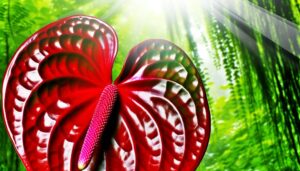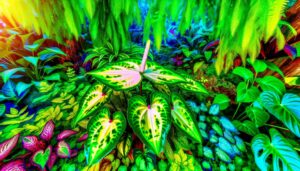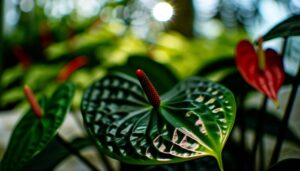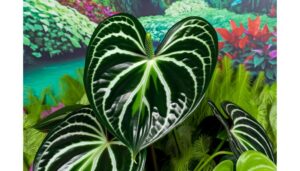Tips for Growing Anthurium Warocqueanum in Australia
To successfully cultivate Anthurium Warocqueanum in Australia, achieve a high-humidity environment (70-90%) with consistent temperatures between 18-24°C. Use a well-draining soil mix of equal parts orchid bark, perlite, and sphagnum moss.
Provide bright, indirect sunlight and avoid direct exposure to midday sun. Water with distilled or rainwater, maintaining consistent moisture without waterlogging.
Implement mechanical humidifiers, pebble trays, and regular misting to achieve prime humidity levels. Monitor for pests, root rot, and nutrient deficiencies, adjusting care as necessary.
Learn how these requirements intertwine to support the growth and health of Anthurium Warocqueanum.
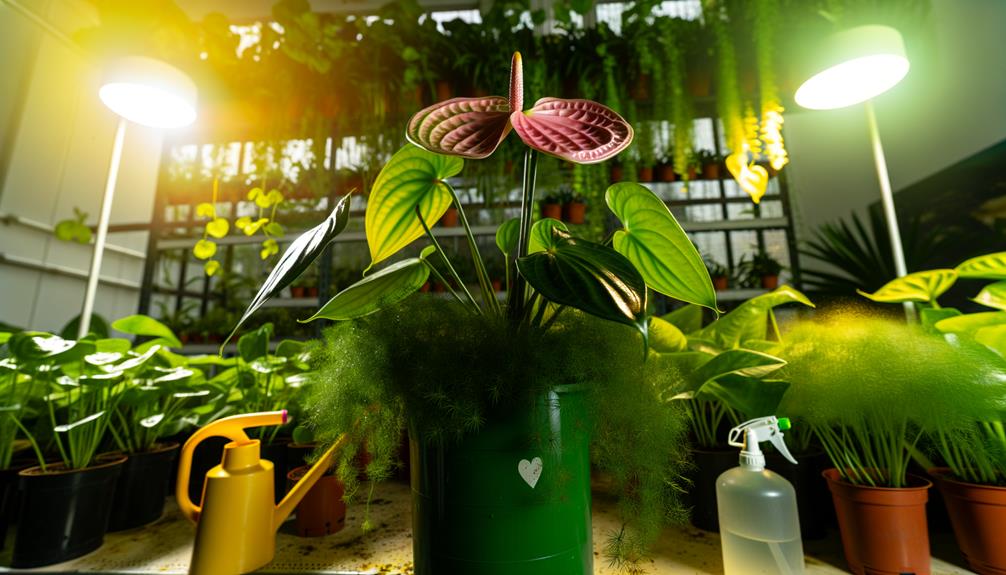
Key Takeaways
- Maintain 70-80% relative humidity using humidifiers, pebble trays, and regular misting.
- Provide bright, indirect sunlight and avoid direct midday sun.
- Use a soil mix of equal parts orchid bark, perlite, and sphagnum moss.
- Water with distilled or rainwater to prevent mineral buildup and ensure effective drainage.
- Monitor for pests and root rot; treat with insecticides and maintain well-aerated substrate.
Understanding Climate Needs
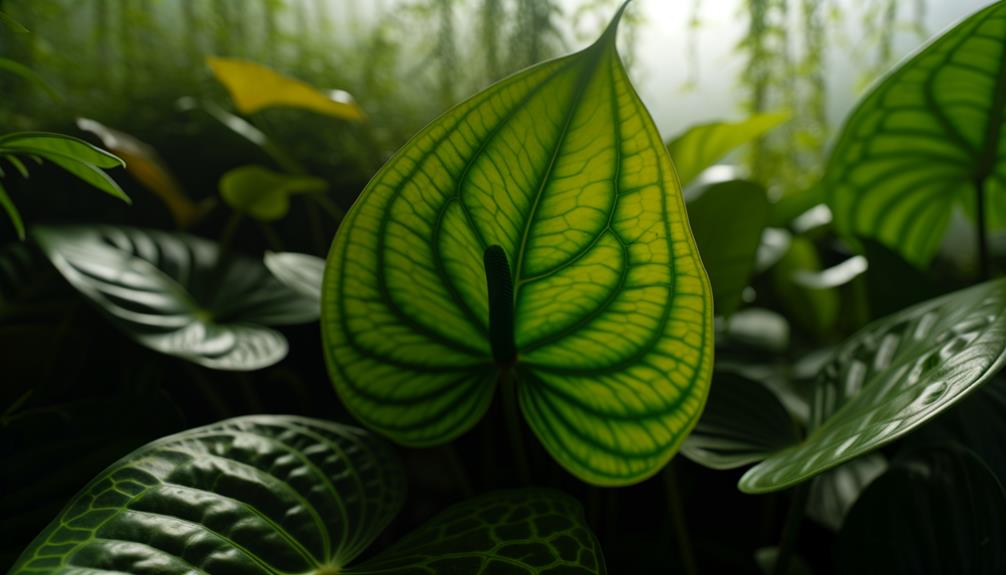
Understanding the specific climate needs of Anthurium warocqueanum is vital for successfully cultivating this tropical plant in the diverse Australian environment.
Native to the rainforests of Colombia, Anthurium warocqueanum thrives in conditions of high humidity, consistent warmth, and diffused light.
Best temperature ranges between 18-24°C, with a relative humidity of 70-80%. This species is particularly sensitive to cold drafts and sudden temperature fluctuations, which can hinder growth and health.
Additionally, maintaining a stable microclimate with good air circulation is optimal to prevent fungal infections and pests.
Light requirements involve bright, indirect sunlight; direct exposure can cause leaf scorch. By replicating these conditions, growers can promote robust development and vibrant foliage, essential for the aesthetic and physiological well-being of the plant.
Ideal Soil Mix
To cultivate Anthurium warocqueanum successfully in Australia, selecting an ideal soil mix that mimics its natural rainforest substrate is crucial.
This species thrives in a well-aerated, porous medium with excellent drainage. A recommended mix includes equal parts of orchid bark, perlite, and sphagnum moss.
Orchid bark provides structural support and aeration, perlite enhances drainage and prevents compaction, while sphagnum moss retains adequate moisture without waterlogging.
Additionally, incorporating activated charcoal can help in absorbing toxins and maintaining root health. The pH should be slightly acidic, ranging between 5.5 to 6.5.
Ensuring this specific soil composition fosters robust growth and mimics the epiphytic conditions of its native tropical habitat, supporting the plant’s physiological needs effectively.
Watering Guidelines
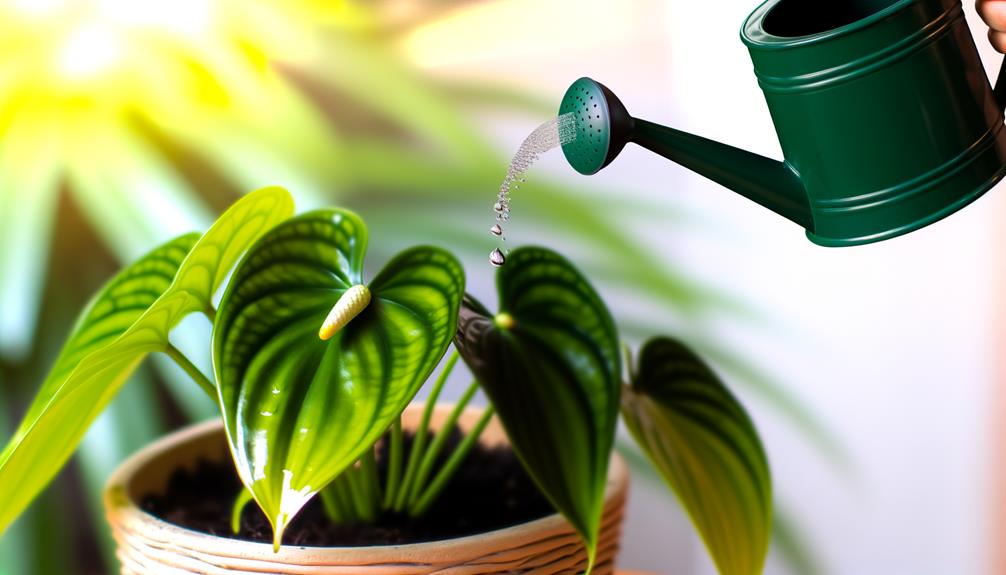
Proper watering of Anthurium Warocqueanum necessitates adherence to ideal frequency to prevent root rot and promote vigorous growth. Utilizing high-quality water, preferably distilled or rainwater, mitigates the risk of mineral buildup and leaf damage.
Additionally, maintaining effective drainage and aeration is essential to support the plant’s epiphytic nature and encourage healthy root systems.
Optimal Watering Frequency
Determining the best watering frequency for Anthurium warocqueanum in Australia necessitates a thorough understanding of its native humid tropical environment and the specific microclimate conditions within the growing area. This species thrives in consistently moist substrates without experiencing waterlogging.
To achieve peak hydration, consider the following guidelines:
- Regular Monitoring: Check the moisture level of the soil every 2-3 days using a moisture meter to prevent both overwatering and underwatering.
- Seasonal Adjustments: During warmer months, increase watering frequency to 2-3 times per week, while reducing it to once weekly in cooler periods.
- Humidity Management: Maintain a relative humidity of 70-80% to mimic its natural habitat, supplementing with misting if necessary.
These methods promote vigorous growth and prevent root rot.
Water Quality Importance
Understanding the importance of water quality is crucial in promoting the health and growth of Anthurium warocqueanum, as this species is particularly sensitive to contaminants and mineral imbalances.
Utilizing filtered or rainwater is recommended, as tap water often contains chlorine, fluoride, and other dissolved minerals that can negatively impact the plant.
Maintaining a water pH between 5.5 and 6.5 is essential, as deviations can hinder nutrient uptake.
Regularly testing water for total dissolved solids (TDS) and adjusting accordingly can prevent potential toxicity. Incorporating a reverse osmosis system can further ensure ideal water purity.
Consistent monitoring and adjusting of water quality parameters will foster a conducive environment for the robust growth of Anthurium warocqueanum.
Drainage and Aeration
Best drainage and aeration are essential for the successful cultivation of Anthurium warocqueanum, as these factors prevent root rot and guarantee sufficient oxygen supply.
Using a well-draining potting mix composed of orchid bark, perlite, and sphagnum moss creates an ideal environment for root health.
Ensuring the pot has ample drainage holes facilitates water flow, reducing water stagnation. Furthermore, incorporating a humidity tray can elevate ambient moisture levels without waterlogging the roots.
To promote optimal growth conditions, consider the following:
- Potting Mix: Utilize a balanced combination of orchid bark, perlite, and sphagnum moss.
- Drainage: Choose pots with multiple drainage holes to prevent water accumulation.
- Humidity: Utilize a humidity tray to maintain high moisture levels without oversaturating the soil.
These measures collectively enhance root strength and plant vigor.
Humidity Requirements
Anthurium Warocqueanum thrives in environments with relative humidity levels between 70% and 90%, necessitating careful monitoring to maintain consistent moisture.
Techniques such as the use of humidifiers, pebble trays, and frequent misting can effectively enhance ambient humidity.
Ensuring these conditions will support the plant’s physiological processes, promoting best growth and leaf development.
Ideal Humidity Levels
Maintaining a relative moisture level between 70% and 80% is crucial for the best growth and health of Anthurium warocqueanum in Australia.
This tropical plant flourishes in high moisture environments, resembling its native rainforest habitat. Inadequate moisture can lead to brown leaf tips and slow growth, while excessive moisture may promote fungal infections.
To achieve the ideal moisture levels, consider the following:
- Humidifiers: Using a high-quality humidifier can greatly elevate ambient moisture, creating an excellent microclimate for your plant.
- Misting: Regularly misting the foliage can provide short-term moisture boosts, especially during drier periods.
- Moisture Trays: Placing the plant on a moisture tray filled with water and pebbles can increase local moisture around the plant.
Implementing these strategies can help optimize your Anthurium warocqueanum’s growth.
Maintaining Consistent Moisture
Consistency in moisture levels is crucial for the best health and growth of Anthurium warocqueanum, necessitating precision in both humidity control and irrigation practices.
Ideal humidity for this species ranges between 70% to 80%, essential for preventing leaf desiccation and promoting cellular function. Employing hygrometers to monitor ambient humidity guarantees adherence to these parameters.
Soil moisture consistency is equally important; substrates should remain evenly moist but not waterlogged to avoid root rot.
Utilize well-draining, aerated potting mixes that facilitate moisture retention without suffocation. Regularly assess soil moisture levels using a moisture meter to prevent fluctuations.
Implementing these practices provides a stable microenvironment conducive to the physiological needs of Anthurium warocqueanum, ensuring robust growth and foliage health.
Humidifying Techniques
To achieve the most suitable humidity levels for Anthurium warocqueanum, integrating a combination of mechanical humidifiers, pebble trays, and regular misting can effectively maintain the required 70% to 80% humidity range. Mechanical humidifiers provide consistent humidity control, essential for the plant’s peak growth.
Pebble trays increase ambient moisture through evaporation, enhancing localized humidity. Regular misting guarantees immediate humidity spikes, beneficial for the plant’s aerial roots.
To evoke a deeper understanding, consider:
- Mechanical Humidifiers: Equip your growing space with a high-quality humidifier to automate and monitor humidity levels.
- Pebble Trays: Place trays filled with water and pebbles beneath the plant to create a micro-climate.
- Regular Misting: Use a fine mist spray daily to keep the leaves hydrated and maintain humidity.
These techniques collectively create an ideal environment for Anthurium warocqueanum.
Light Conditions

Perfect light conditions are vital for the healthy growth of Anthurium Warocqueanum, requiring bright, indirect sunlight to replicate its natural rainforest habitat. Direct sunlight exposure can result in leaf scorch and chlorophyll degradation, leading to subpar photosynthesis.
Position the plant near east or north-facing windows to guarantee ample diffused light, while avoiding harsh midday sun. Utilizing sheer curtains or shade cloth can help moderate light intensity.
Supplemental artificial lighting, such as LED grow lights with a spectrum close to natural sunlight, can be advantageous, especially during shorter winter days.
Maintaining consistent light levels is essential, as fluctuations can induce stress and inhibit growth. Regularly monitor light intensity using a light meter to ensure best conditions.
Common Issues and Solutions
Understanding the common issues that affect Anthurium Warocqueanum, such as root rot, pest infestations, and nutrient deficiencies, is crucial for implementing effective solutions.
Root rot, often caused by overwatering and poor drainage, can be lessened by using a well-aerated, chunky substrate.
Pest infestations, including spider mites and aphids, require vigilant monitoring and timely intervention with appropriate insecticidal treatments.
Nutrient deficiencies, manifested as yellowing leaves or stunted growth, can be addressed by a balanced fertilization regimen, ensuring the plant receives essential macro and micronutrients.
Here are three critical actions to evoke prime plant health:
- Monitor soil moisture: Prevent root rot by ensuring proper drainage.
- Inspect regularly for pests: Early detection and treatment are crucial.
- Fertilize appropriately: Use a balanced, slow-release fertilizer.
Conclusion
To successfully cultivate Anthurium warocqueanum in Australia, one must consider the plant’s specific climate needs, ideal soil mix, precise watering guidelines, strict humidity requirements, and best light conditions.
By addressing common issues with scientifically-backed solutions, the grower can achieve a thriving plant.
Adherence to these detailed guidelines creates an environment where Anthurium warocqueanum can flourish, showcasing its unique foliage and contributing to the diversity of indoor horticulture.

